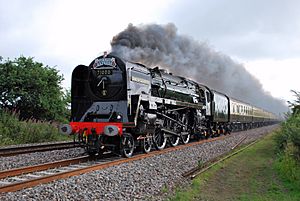BR Standard Class 8 facts for kids
Quick facts for kids BR Standard Class 8 |
|
 |
|
| No.71000 "Duke of Gloucester" hammering across the Somerset Levels on the Torbay Express | |
| Power type | Steam |
|---|---|
| Designer | Robert Riddles |
| Builder | BR Crewe Works |
| Build date | April 1954 |
| Total production | 1 |
| Configuration | 4-6-2 (Pacific) |
| UIC classification | 2′C1′h3 |
| Gauge | 4 ft 8 1⁄2 in (1,435 mm) standard gauge |
| Leading wheel diameter | 3 ft 0 in (0.914 m) |
| Driver diameter | 6 ft 2 in (1.880 m) |
| Trailing wheel diameter | 3 ft 3+1⁄2 in (1.003 m) |
| Length | 67 ft 8 in (20.62 m) |
| Width | 9 ft 0 in (2.74 m) |
| Height | 13 ft 0+1⁄2 in (3.98 m) |
| Axle load | 22.00 long tons (24.64 short tons; 22.35 t) |
| Weight on drivers | 66.00 long tons (73.92 short tons; 67.06 t) |
| Locomotive weight | 101.25 long tons (113.40 short tons; 102.87 t) |
| Tender weight | BR1E: 55.50 long tons (62.16 short tons; 56.39 t) BR1J: 53.70 long tons (60.14 short tons; 54.56 t) |
| Tender type | 1954–1958: BR1E 1958–1962: BR1J |
| Fuel type | Coal |
| Fuel capacity | 10 long tons (11 short tons; 10 t) |
| Water capacity | BR1E: 4,725 imp gal (21,480 L; 5,674 US gal) BR1J: 4,325 imp gal (19,660 L; 5,194 US gal) |
| Boiler | BR13 |
| Boiler pressure | 250 psi (1.72 MPa) |
| Fire grate area | 48.6 sq ft (4.52 m2) |
| Heating surface: Tubes and flues | 2,264 sq ft (210.3 m2) |
| Heating surface: Firebox | 226 sq ft (21.0 m2) |
| Superheater area | 677 sq ft (62.9 m2) |
| Cylinders | Three |
| Cylinder size | 18 in × 28 in (457 mm × 711 mm) |
| Tractive effort | 39,080 lbf (173.84 kN) |
| Factor of adhesion | 3.78 |
| Power class | 8P |
| Locale | London Midland Region |
| Withdrawn | December 1962 |
| Disposition | Preserved |
The BR Standard Class 8 was a very special type of steam locomotive built for British Railways. Only one of these powerful engines was ever made. It was named Duke of Gloucester. This unique locomotive was designed by Robert Riddles and built in 1954 at Crewe Works. It's often called simply the Duke.
The Duke was created to replace another engine, the Princess Anne. That locomotive had been badly damaged in a railway accident in 1952.
Contents
What is the Duke of Gloucester?
The Duke of Gloucester is a type of steam locomotive known as a Pacific. This name comes from its wheel arrangement, which is 4-6-2. This means it has four small wheels at the front, six large driving wheels in the middle, and two small wheels at the back.
Why was it built?
The Duke was built as an experimental locomotive. It was meant to be a very powerful engine for pulling express passenger trains. It was designed to be efficient and modern for its time.
Special Features
The Duke had some unique features that made it stand out. It was one of the few British steam locomotives to have three cylinders. These cylinders helped it produce a lot of power. It also used a special type of valve gear called British Caprotti valve gear. This helped the engine work more efficiently.
Life of the Duke
The Duke of Gloucester entered service in April 1954. It was mainly used on the London Midland Region lines. It pulled important passenger trains across the country.
Withdrawal from Service
Despite its advanced design, the Duke had a relatively short working life. It was withdrawn from service in December 1962. This was part of a bigger plan to replace steam locomotives with diesel and electric trains.
Preservation
After being withdrawn, the Duke of Gloucester was saved from being scrapped. It was bought by a group of railway fans who wanted to restore it. This was a huge project, as the locomotive needed a lot of work.
Restoration Journey
The restoration of the Duke took many years. Volunteers worked hard to bring it back to its original condition. They cleaned, repaired, and rebuilt many parts of the engine. It was a true labor of love.
Back on the Tracks
Thanks to the dedication of its restorers, the Duke of Gloucester returned to the main railway lines. Today, it is a preserved locomotive. It often pulls special heritage trains and enthusiast tours. Seeing it in action is like stepping back in time.
Gallery
-
71000 on the 9th of June 2007 approaching Shap at slow speed, taken just 5 minutes before the locomotive failed at Penrith. The locomotive was approaching the hill at slow speed and incapable of much traction.
Images for kids
-
71000 Duke of Gloucester on the East Lancashire Railway. Note British Caprotti valve gear.
-
71000 at the terminus of the West Somerset Railway at Minehead
-
No 71000 Duke of Gloucester on the East Lancashire Railway






